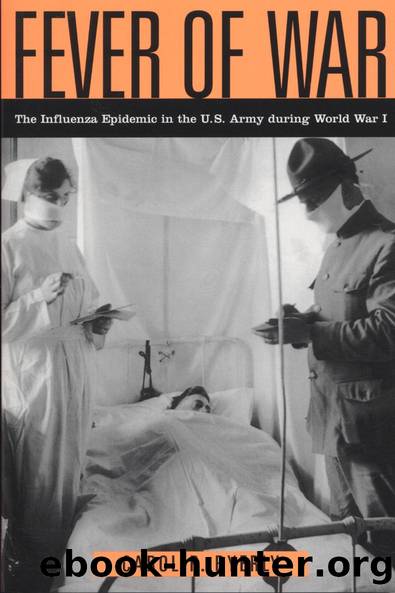Fever of War by Carol R Byerly

Author:Carol R Byerly [Byerly, Carol R]
Language: eng
Format: epub
Tags: History, Military, World War I, United States, 20th Century, Medical
ISBN: 9780814799246
Google: haCUuvaj-58C
Publisher: NYU Press
Published: 2005-04-05T22:16:45+00:00
The Third Wave
Despite the November 1918 armistice, the war and the flu were not over for everyone. Many Americans had to stay in Europe because troop ships had been returned to commerce and were not available to take people home quickly. Pershing had also formed another army. The AEFâs Third Army joined the Allied Army of Occupation and moved into the Rhineland to ensure the terms of the Armistice and keep pressure on the Germans during the treaty negotiations. As the training camps at home hastily emptied, many of the two million soldiers languished in France until the spring and summer of 1919.
Soldiers and medical officers alike fell prey to a third wave of influenza which swept the world: another wave of death and failure. The third wave was not unexpected. Medical scientists were familiar with cycles of flu outbreaks, and Jay Grissinger, Third Army chief surgeon, was prepared: he had requested 5,000 hospital beds for the 240,000-man army. When the commanding general approved only 2,100 beds, Grissinger went over his head to the army chief of staff and got his 5,000. âThe soundness of our calculation,â he later wrote, âwas abundantly proven during the early months of 1919 when an outbreak of respiratory disease was encountered.â108 But even if expected, the third wave of influenza seemed especially cruel because it killed people who had survived the war. As one officer remarked, âPerhaps nothing touched the hearts of the American people more than did the deaths of those who had survived strenuous training, an ocean voyage fraught with peril, enemy shells, and disease, only to succumb to illness after all warfare was over.â109 Medical officer William Dyer had to watch a patient, Private Ben Eggleston, die of pneumonia aboard the Aquitania on 27 February 1919, just two days before the ship landed in New York.110
During the first three months of 1919, the Third Army hospitalized more than 31,000 men. While only 13,000 of these had respiratory illnesses, 90 percent of the deaths were from the flu and pneumonia. In the Forty-second Division, 30 percent of one regiment fell ill with the flu, and Frederick Pottleâs evacuation hospital had seventeen deaths during the first week of January.111 The epidemic prompted a spate of medical bulletins, inspections, and a special investigation of respiratory disease in the Army of Occupation, none of which shed new light on the problem.112 Medicine was as ineffectual as during the first and second waves, but AEF medical services seemed, if anything, a little more frantic. A Third Army bulletin issued during the epidemic warned medical officers and line commanders that âsick casualties only differ from battle casualties in that they are largely preventable,â and âsickness is not a dispensation of Providence, but usually a breach of discipline and sanitary offense.â The bulletin ended ominously: âEpidemics do not occur in well regulated companies,â suggesting that any outbreaks signified incompetence or laxity on the part of the medical and line officers in charge.113
Bed rest, alcohol baths, and aspirin could not prevent Clair F.
Download
This site does not store any files on its server. We only index and link to content provided by other sites. Please contact the content providers to delete copyright contents if any and email us, we'll remove relevant links or contents immediately.
| Administration & Medicine Economics | Allied Health Professions |
| Basic Sciences | Dentistry |
| History | Medical Informatics |
| Medicine | Nursing |
| Pharmacology | Psychology |
| Research | Veterinary Medicine |
The Immortal Life of Henrietta Lacks by Rebecca Skloot(4525)
An American Plague by Jim Murphy(3710)
The Emperor of All Maladies: A Biography of Cancer by Siddhartha Mukherjee(3064)
The Gene: An Intimate History by Siddhartha Mukherjee(3047)
The Fate of Rome: Climate, Disease, and the End of an Empire (The Princeton History of the Ancient World) by Kyle Harper(3003)
Rebecca Skloot by The Immortal Life of Henrietta Lacks(1978)
Stiff - The Curious Lives of Human Cadavers by Mary Roach(1814)
The Great Influenza by John M Barry(1750)
The Vaccine Race by Meredith Wadman(1628)
Undue Risk by Moreno Jonathan D.;(1600)
Hero by Michael Grant(1585)
Three Cups of Tea by Greg Mortenson(1576)
The Mystery of the Exploding Teeth by Thomas Morris(1540)
Quackery by Lydia Kang(1519)
Autism's False Prophets by Paul A. Offit(1496)
Extremes: Life, Death and the Limits of the Human Body by Fong Kevin(1484)
A Journal of the Plague Year (Oxford World's Classics) by Daniel Defoe(1480)
Steroids: History, Science, and Issues by Standora Joan E.; Bogomolnik Alex; Slugocki Malgorzata(1479)
The Vaccine Court by Rohde Wayne(1471)
